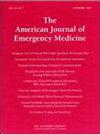Ethanol and lactate: Is there a direct association?
IF 2.2
3区 医学
Q1 EMERGENCY MEDICINE
引用次数: 0
Abstract
Introduction
Ethanol intoxication is frequently encountered in the Emergency Department (ED), often alongside comorbid conditions. Serum lactate, a clinical biomarker for illness severity, is hypothesized to elevate during acute ethanol intoxication due to altered redox states. Providers may defer lactate testing in intoxicated patients due to interpretation uncertainty, though this relationship remains unquantified.
Methods
We conducted a retrospective study of two cohorts of adult patients who had a serum ethanol measured during an ED encounter, one in a large academic health system from January 1, 2013 to January 30, 2023 and the other in the Veterans Health Administration (VHA) from 2010 to 2019. Patients with diagnoses or medications associated with lactic acidosis were excluded. A de-identified dataset including laboratory results, demographics, and vital signs were obtained. Descriptive statistics and regression analyses were performed.
Results
In the academic center cohort, regression analysis showed poor correlation between ethanol and lactate concentrations (r2 = 0.00110). Subgroup analyses of ethanol concentrations >80 mg/dL and > 200 mg/dL also showed poor correlation (r2 = 0.00570 and 0.00068 respectively).
In the VHA cohort, regression analysis similarly revealed no correlation (Pearson's correlation coefficient r = −0.00019 with P = 0.9899).
Discussion
This retrospective analysis found poor correlation between ethanol and lactate concentrations in both cohorts. Elevated lactate should not be attributed to ethanol alone. While effort was taken to exclude potential confounders, the causes of lactic acidosis are numerous, and confounders may remain. Prospective studies could better clarify any relationship between ethanol and lactate concentrations.
Conclusion
Ethanol intoxication does not justify deferring lactate testing when clinically indicated. Elevated lactate concentrations should prompt evaluation for alternative causes.
乙醇和乳酸:有直接的联系吗?
简介:乙醇中毒是经常遇到在急诊科(ED),往往伴随着合并症的条件。血清乳酸,疾病严重程度的临床生物标志物,被假设在急性乙醇中毒期间由于氧化还原状态的改变而升高。由于解释的不确定性,提供者可能会推迟醉酒患者的乳酸检测,尽管这种关系仍未量化。方法:我们对两组在ED遭遇期间测量血清乙醇的成年患者进行了回顾性研究,一组患者于2013年1月1日至2023年1月30日在大型学术卫生系统中,另一组患者于2010年至2019年在退伍军人健康管理局(VHA)中。排除诊断或用药与乳酸酸中毒相关的患者。获得去识别数据集,包括实验室结果、人口统计数据和生命体征。进行描述性统计和回归分析。结果:在学术中心队列中,回归分析显示乙醇与乳酸浓度相关性较差(r2 = 0.00110)。乙醇浓度bbb80 mg/dL和bbb200 mg/dL的亚组分析也显示出较差的相关性(r2分别为0.00570和0.00068)。在VHA队列中,回归分析同样显示无相关性(Pearson相关系数r = -0.00019, P = 0.9899)。讨论:这项回顾性分析发现,在两个队列中,乙醇和乳酸浓度之间的相关性很差。乳酸升高不应仅仅归因于乙醇。虽然努力排除潜在的混杂因素,但乳酸酸中毒的原因很多,混杂因素可能仍然存在。前瞻性研究可以更好地阐明乙醇和乳酸浓度之间的关系。结论:临床指征时,乙醇中毒不能作为推迟乳酸检测的理由。乳酸浓度升高应提示评估其他原因。
本文章由计算机程序翻译,如有差异,请以英文原文为准。
求助全文
约1分钟内获得全文
求助全文
来源期刊
CiteScore
6.00
自引率
5.60%
发文量
730
审稿时长
42 days
期刊介绍:
A distinctive blend of practicality and scholarliness makes the American Journal of Emergency Medicine a key source for information on emergency medical care. Covering all activities concerned with emergency medicine, it is the journal to turn to for information to help increase the ability to understand, recognize and treat emergency conditions. Issues contain clinical articles, case reports, review articles, editorials, international notes, book reviews and more.

 求助内容:
求助内容: 应助结果提醒方式:
应助结果提醒方式:


